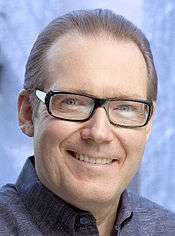Michael A. Rogers
| Michael Rogers | |
|---|---|
 | |
| Occupation | Author and Futurist |
Michael A. Rogers is an author and futurist who served two years (2006-8) as futurist-in-residence for The New York Times Company.[1][2] He is a columnist for MSNBC.com,[3] and also helps businesses and organizations worldwide think about the future. In recent years he has worked with companies including FedEx, Boeing and NBC Universal to Prudential, Dow Corning, American Express and Genentech.[4]
Biography
Rogers graduated from Stanford University in 1972 with a Bachelors in Creative Writing and minor in Physics, with additional training in finance and management at Stanford Business School’s Executive Program.
Media and Technology Career
For ten years Rogers was vice president of The Washington Post Company's new media division, overseeing both the newspaper and its sister publication Newsweek, as well as serving as editor and general manager of Newsweek.com. He is also a regular guest on radio and television including Good Morning America, The Today Show, PBS, CNN and The History Channel.
He began his career as a writer for Rolling Stone and went on to co-found Outside Magazine. He then launched Newsweek’s technology column, winning numerous journalism awards, including a National Headliner Award for coverage of Chernobyl and a Distinguished Online Service award from the National Press Club for coverage of 9/11.[5]
He began working with interactive media in 1986, when he developed the storyline for the first Lucasfilm computer game. In 1993 he produced the world's first CD-ROM newsmagazine for Newsweek, going on to develop areas on Prodigy, America Online and then a series of Internet sites. In 1999 he received a patent for the bimodal spine,[6] a multimedia storytelling technique, and is listed in Who’s Who in Science and Engineering. In 2007 he was named to the Magazine Industry Digital Hall of Fame, and in 2009 he received the World Technology Network Award for Achievement in Media and Journalism.[7]
He regularly addresses venture capitalists, corporate executives, educators, students and the general public. In 1989 he was founding chairperson of the European Technology Roundtable, an annual CEO gathering, along with the Asian Technology Roundtable. Rogers is also a best-selling novelist whose fiction explores the human impact of technology. He lives in New York City.
Publications
Books
Mindfogger (Novel; Knopf, 1973) ISBN 978-0-394-48401-3[8]
Do Not Worry About the Bear (Short stories; Knopf, 1977) ISBN 978-0-394-50191-8[9]
Biohazard (Nonfiction; Knopf, 1979) ISBN 978-0-394-40128-7[10]
Silicon Valley (Novel; Simon & Schuster, 1983) ISBN 978-0-671-41030-8[11]
Forbidden Sequence (Novel; Bantam, 1989) ISBN 978-0-553-27080-8[12]
Periodicals
Rogers' fiction, nonfiction, criticism and photography has been published in magazines including Look, Esquire, Playboy and the New York Times, and in anthologies.
Interactive media
- Console
- 1986: BALLBLAZER; Lucasfilm Games; Atari 2600 (writer) Laserdisc/Macintosh
- 1989: UPHEAVAL IN CHINA; Newsweek; limited release (producer/managing editor)
- Diskette
- 1990: NOT EXACTLY UNIQUE; Tor Productions; limited release (co-producer/writer)
- CD-ROM
- 1993: UNFINISHED BUSINESS: MENDING THE EARTH; Sony MMCD (producer/managing editor)
- 1994: Newsweek InterActive Documentary Series; Sony MMCD/Software Toolworks, DOS (Producer/Managing Editor)
- VOLUME I: UNFINISHED BUSINESS/THE BUSINESS OF BASEBALL
- VOLUME II: BEHIND THE SCREENS/ WHAT AILS US?
- VOLUME III: GLOBOCOP/THE SECRET LIFE OF ANIMALS
- 1995: DRIVING THE DATA HIGHWAY; Newsweek; Macintosh/Windows (writer-producer), NEW MEDIA AT THE WASHINGTON POST COMPANY; Digital Ink; Macintosh/Windows (producer)
- 1996: NEWSWEEK PARENT’S GUIDE TO CHILDREN’S SOFTWARE; Digital Ink; Macintosh/Windows (executive producer/writer/host)
Honors and awards
- 1974: American Association for the Advancement of Science Distinguished Science Writing[13]
- 1988: National Headliners Award
- 1989: Computer Press Association Outstanding Feature Writing
- 2003: National Press Club Award for Distinguished Contribution to Online Journalism, for coverage of 9-11 on Newsweek.com[5]
- 2007: Magazine Industry Digital Hall of Fame Inductee[14]
- 2009: World Technology Network Award for Achievement in Media and Journalism[15]
Employment
- 2006–Present: Principal, Practical Futurist (New York City)
- 2006 - 2008: Futurist in Residence, The New York Times
- 1996 - 2006: Vice President, Editorial Research and Development, Washington Post-Newsweek New Media
- 1995 - 1996: Executive Producer, Broadband Division, The Washington Post Company
- 1992 - 1995: Managing Editor, Newsweek InterActive
- 1991 - 1994: Senior Writer, Newsweek Magazine
- 1983 - 1991: General Editor, Newsweek Magazine
- 1978 - 1982: Contributing Editor, Rolling Stone Correspondent, Outside
- 1977 - 1978: Co-Founder and Editor-at-Large, Outside Magazine
- 1972 - 1976: Associate Editor, Rolling Stone
References
- ↑ "Michael Rogers". I Want Media. Retrieved 2012-02-23.
- ↑ Hogan, Ron (2007-11-13). "The Futurist in the NYT Attic - GalleyCat". Mediabistro.com. Retrieved 2012-02-23.
- ↑ Updated 103 minutes ago 2/23/2012 8:05:52 PM +00:00 (2006-09-20). "Technology & science - Innovation - The Practical Futurist - msnbc.com". MSNBC. Retrieved 2012-02-23.
- ↑ "Michael A. Rogers Bio" Retrieved 22 July 2015
- 1 2 "Events - GTC West 2012". Government Technology. Retrieved 2013-10-20.
- ↑ "United States Patent: 5915256". Patft.uspto.gov. Retrieved 2012-02-23.
- ↑ "The World Technology Summit 2010". Wtn.net. 2010-12-01. Retrieved 2012-02-23.
- ↑ Michael Rogers (1973). Mindfogger. Alfred A. Knopf Incorporated. ISBN 978-0-394-48401-3. Retrieved July 23, 2013.
- ↑ Michael Rogers (January 1, 1979). Do Not Worry about the Bear: Stories. Knopf. Retrieved July 23, 2013.
- ↑ Michael Rogers (1977). Biohazard. Alfred A. Knopf. ISBN 978-0-394-40128-7. Retrieved July 23, 2013.
- ↑ Michael Rogers (January 1, 1982). Silicon Valley: A Novel. Simon and Schuster. ISBN 978-0-671-41030-8. Retrieved July 23, 2013.
- ↑ Michael Rogers (December 1, 1987). Forbidden Sequence. Bantam Books. ISBN 978-0-553-27080-8. Retrieved July 23, 2013.
- ↑ "AAAS - The World's Largest General Scientific Society". Archives.aaas.org. 1973-10-11. Retrieved 2012-02-23.
- ↑ "min's Best of Web Winners". MinOnline. Retrieved 2012-02-23.
- ↑ "The World Technology Summit & Awards 2009". Wtn.net. Retrieved 2012-02-23.
External links
- Official website
- A conversation with Rogers on technology and innovation, ideaconnection.com
- An article about the future of journalism and the New York Times, Financial Times
- An interview with Michael Rogers, nytco.com
|